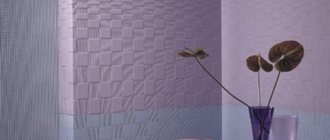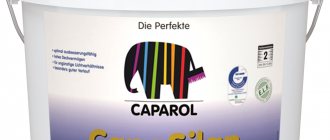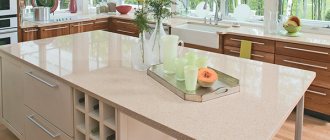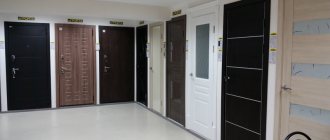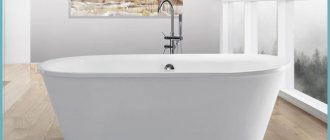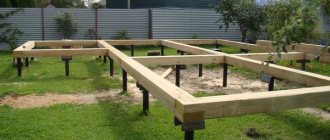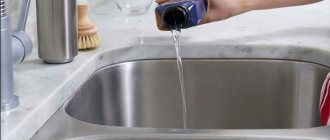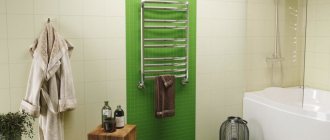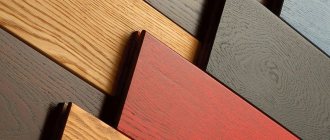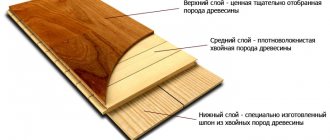- May 27, 2019
- Tools and equipment
- Elena Korpach
When choosing materials for finishing, many try to choose the ideal putty option that can hide rough work. The final finish does not always need to be covered with decorative materials to mask errors and minor irregularities. The appearance of the walls will depend on the type and quality of the finishing mortar. Let's take a closer look at which finishing putty is better.
Is there a difference between putty and putty?
In construction there are two terms: “putty” and “putty”. Many manufacturers use both names, confusing novice craftsmen. The first version of the name of the finishing material came to us from Germany. A spatula was a construction tool that resembled a spatula, which was used to apply leveling mortar to the wall. Later, the term “putty” began to refer to the finishing process itself. Now the concepts of “putty” and “putty” are considered equal.
Preparation of tools and equipment
Before starting the repair, the master will need the following equipment:
- durable container for mixing the solution;
- container for washing solution from instruments;
- electric drill;
- attachment (mixer) for drill;
- Master OK;
- set of spatulas;
- Sander;
- or a paint grater with a clamp for sandpaper;
- set of sanding sheets.
After preparing the tools, you can begin to work.
Apply putty using a spatula
Why is finishing putty necessary?
Many craftsmen believe that there is no need to apply finishing putty, since dry compounds perfectly hide small defects. This opinion is wrong. For wallpaper and painting, careful leveling is necessary. Finishing compounds bring the surface to ideal condition due to the minimum size of the fractions. The size of the grains in this composition does not exceed 0.5 mm. The range includes gypsum, polymer and cement mixtures. Many people find it difficult to determine which finishing putty is best for walls.
Which putty should I choose in which situation: gypsum or polymer?
Knowing the differences between gypsum and polymer putties, it’s time to stop asking the question which is better, and choose the right material depending on the situation.
- for a gypsum base - gypsum finishing composition, for a cement base - any option;
- for wallpaper - plaster, for painting - polymer (the fineness of the fraction of the polymer solution will ensure an ideal surface);
- in a dry room - gypsum, in a damp room - polymer (it will protect against moisture, mold and mildew);
- for ordinary drywall - gypsum, for moisture-resistant drywall - polymer;
- for old plaster (or putty, paint) - only polymer;
- for plywood and chipboard - only polymer, pre-impregnated with an antiseptic;
- outdoors - only acrylic polymer.
Types of finishing mixtures
Gypsum plaster produces a smooth white surface. 30 minutes after dilution, the solution loses its construction characteristics, so it requires quick application. It is diluted in small quantities. Drying time is up to 2 hours. The layer thickness does not exceed 2 mm. The material is not suitable for rooms with high humidity.
Cement mortar, as a finishing putty, is better suited for rooms with high humidity. It is water resistant and easy to apply. Laying a layer thicker than 2 mm is allowed, but it may shrink after some time. This solution is suitable for finishing bathrooms, kitchens, toilets and facades.
Polymer plaster is ideal for wallpaper and painting. It creates a perfectly smooth surface, forming reliable adhesion to the wall. The solution is suitable for use for a long time. It is applied in a layer of up to 0.2 mm. Many people find it difficult to choose which finishing putty is better: polymer, gypsum or cement. Note that the polymer mixture is suitable for small areas due to the high cost of the material.
Features of choosing a finishing putty
Finally, you should pay attention to a few more useful recommendations that will help you make your choice:
- Almost any composition is suitable for walls. However, if you are planning to decorate a bedroom, nursery, hallway or living room, then you should give preference to gypsum compositions. But for the bathroom and other wet rooms, the best option would be acrylic or cement putty.
- When it comes to finishing the ceiling, acrylic compounds are most often used, but gypsum compounds can also be suitable. Acrylic is also used when working with wood and drywall.
- For finishing walls outside, it is better to give preference to a cement or acrylic mixture.
- Raw concrete is often covered with several layers of cement putty.
Thus, today you can choose from a wide variety of different compositions. An experienced craftsman can also handle cement putty, and if the work is being carried out for the first time, it is better to give preference to more elastic compounds.
Features of use
When choosing which finishing putty is best, in addition to the degree of moisture, you should consider the needs of the finish. The gypsum mixture is distributed in a dense layer. It fits perfectly with wallpaper. Pasting with heavy, textured and thin canvases is allowed. It is recommended to choose a polymer composition for painting. The solution does not require dilution and is suitable for use immediately after opening the container. Painting is done in one layer. It is better to choose a cement analogue for budget finishing. Most often it is purchased for preparing walls for painting in basements, garages, and entrances. It should be remembered that the cement layer cannot be ground.
Features of puttying with a polymer composition over paint
It is not recommended to apply putty on painted surfaces. If possible, it is better to remove as much old paint as possible. If this is not possible, you must:
- check the strength of the paint;
- clean the surface in places where it is chipped and rub it with a paint brush;
- prime;
- putty with a polymer compound.
There is also cement-based putty. However, when working with it, it is impossible to obtain a perfectly flat surface. However, it does not adhere well to painted, wooden and plastic surfaces.
The paint must be cleaned off before finishing work.
Having studied comprehensive information about the difference between polymer and gypsum putty, you can safely purchase the desired mixture in paper packaging or plastic containers and begin repair work. The finishing will be of high quality if you follow the tips and recommendations given in this article step by step.
What do you think about the difference between gypsum and polymer putty? Share in the comments!
How to determine profitability of use?
When considering which finishing putty is best for interior work, you need to take into account the cost of the work and whether the costs fit into the budget. For the calculation, take the area of the treated surfaces and the average consumption per 1 m2, which the manufacturer indicates on the packaging. Depending on the thickness of application, the consumption is:
- up to 0.5 mm – 0.45-0.5 kg/m2;
- 1 mm – 0.9-1.2 kg/m2;
- 5 mm – 4.5 kg/m2.
It is quite difficult to calculate the actual consumption. It is necessary to take into account the condition of the walls and the thickness of the coating. In the process of finishing work, the mixture is most often applied with a thickness of 1 mm; for calculation, a rate of 1.2 kg of putty is taken for each square meter.
Characteristics of gypsum putty
Gypsum putty is produced in the form of dry mixtures and paste solutions, which include:
- plaster (less often alabaster);
- mineral fillers in the form of porous sand (quartz) and marble flour;
- water-soluble polymers, which provide the composition with binding ability, increase moisture retention and film formation;
- additives to retard setting.
The material is vapor permeable and is used for finishing rooms with moderate humidity.
Gypsum putty is not suitable for work outdoors, in the bathroom, toilet and kitchen.
There are many types of putties, differing in the type of main filler
Dry mixes
Raw materials in the form of dry mixtures are packaged in bags weighing 20-25 kg. This putty can be stored for more than 1 year and can be diluted with water either according to the instructions indicated on the package or at your own discretion, making it thicker or thinner. The solution must be made in small portions, as it hardens within half an hour.
Dry putty mixture is sold in bags of various packaging
Paste mixture
Already prepared compositions are sold in plastic buckets of different capacities. Unlike dry mixtures, they have a much shorter shelf life.
The paste mixture is completely ready for use
Practical use of gypsum putty
Gypsum mixtures are intended for application to surfaces made of:
- brick and stone masonry;
- drywall;
- wood
- concrete.
Mixtures containing gypsum are used for:
- masking seams and joints;
- sealing cracks and chips;
- leveling the surface for painting and wallpapering;
- creating stucco on the ceiling;
- for the design of arches, columns, cornices, window and door openings;
- other restoration work.
Gypsum-containing putty is divided into:
- starting;
- finishing;
- universal.
If you need a perfectly flat surface, then you should first use the starting putty, then the finishing putty. The universal composition is suitable for wallpapering and for applying decorative textures.
The use of gypsum putty is possible only when finishing internal walls and ceilings
Starting (base) mixture
Used during initial application to the base. The putty contains large fractions (up to 0.63 mm), so the surface will not be perfectly smooth, but the composition is quite suitable for wallpapering.
Finishing mixture
It is applied to the base for final leveling and consists of small fractions (up to 0.1 mm) and plasticizers. The surface will be smooth and elastic, ready for both painting and wallpapering.
Universal
The name speaks for itself, while the master saves time and does not spend extra money on material. The surface is quite smooth and can be used for painting and wallpapering.
The consumption of gypsum material is about 1.2 kg per 1 m².
Starting
Finish
Universal
Requirements for finishing solutions
When deciding which finishing putty to choose, you should pay attention to its characteristics. It must have excellent adhesion, eliminating the possibility of peeling of decorative coatings applied on top of it. The mixture should have the following properties:
- Apply to base putty without lumps, tracks or grains. Stickiness behind a spatula or other tool is not allowed.
- The finished mixture does not spread over the wall or run off after application.
- When applied in a layer of up to 3 mm, it hides small defects on the wall and imperfections after applying the base putty.
- No holes, cracks, air cavities, or cracking after drying.
- Uniform white color without yellowness or any other extraneous shades.
Characteristics of polymer putty
The polymer substrate is only a finishing one. It is sold both in packaging bags of 20-25 kg and in plastic containers of different weights. The polymer mass consists of:
- acrylic;
- latex;
- polymer cement;
- fine-grained mineral components;
- modifiers (additional additives as intended);
- chemical and natural components.
Polymer putty is compatible with different types of surfaces, adheres well and does not peel off after application, and is very convenient to use.
Polymer putty is characterized by plasticity and versatility of use.
Reasons for application:
- plaster;
- plasterboard;
- concrete;
- woody;
- plastered surfaces.
Polymer putty is not applied to metal, and for facades it cannot be used on a latex basis, due to intolerance to temperature changes and precipitation.
The composition is suitable for finishing a bathroom, toilet, kitchen, facade (except for latex-based putty).
When using a dry mixture, you must dilute it in the proportion indicated on the package - after this the mixture will be suitable for 12 hours. When working with a liquid solution, after opening the package, the shelf life is 2-3 days.
About 1.4 kg of product is consumed per 1² m.
The material is used for final finishing, does not shrink, has no strong odor, is resistant to chemicals, and has good adhesion.
Latex mixtures are available in different colors.
The polymer composition can be applied to a gypsum base, because has high adhesion characteristics
How to choose putty?
If it is difficult to decide which finishing putty is best to choose for your purposes, use our recommendations. The mixture should be purchased from the same manufacturer for all stages of finishing work. It is recommended to pre-treat porous surfaces with a primer. The solution gains strength within 10-15 minutes after dilution. Before applying it, you need to stir it every time so that the uniformity of the consistency is not lost. If the solution is not stirred, lumps will appear in it, which will harden into pebbles.
Important! Before purchasing, you should study the dilution technology to determine whether the mixture is suitable for the given job. Failure to follow the recommendations leads to serious disruptions in technological processes, peeling of the material and a decrease in the service life of the decor.
Basic requirements and quality standards
A high-quality putty for painting should be:
- Soft and elastic.
- Elastic. It should not flow when applied.
- Resistant to cracking. Should shrink slightly as it dries.
- Homogeneous. There should be no lumps in the structure of the solution.
- White. Other shades may show through light paint. Stains on the treated surface are also unacceptable.
Considering all these properties, you can purchase high-quality putty for wall finishing.
The finished putty solution must be homogeneous, plastic and pliable when applied to the surface
What type of putty is best?
Cement putty is suitable for arranging rooms with high humidity and finishing facades. It is resistant to water, so it is ideal for bathrooms, kitchens, lavatories, saunas, gyms, and swimming pools. Disadvantages include an increased tendency to shrinkage and cracking.
Gypsum putty should be chosen for dry rooms. The material is sensitive to moisture, attracts it and becomes damp, and can become a source of mold in damp areas. Many people choose a finishing putty for wallpaper, which is better, according to reviews. Craftsmen say that it is ideal as a finish called “fur coat”. The mixture sets very quickly. It will take about 2 hours to fully cure.
Polymer putty is chosen for rooms with normal humidity levels. It is easy to apply in a very thin layer, economical, and forms a coating that does not need to be further decorated. Ready-made polymer putty is an expensive coating, so it is not profitable to use it over large areas.
What are putty mixtures made of?
The product contains three main components. First, an astringent powdery substance. After mixing with water, it turns into a paste and then into a solid state. Secondly, the filler, which is most often ground marble, limestone, and chalk. And thirdly, modifying additives that improve the properties of the solution. By the name you can immediately understand which substance in this product is the binder: in cement - cement, in gypsum - gypsum, in polymer - polymers.
Cement
Cement mortars create a durable, water-resistant layer, and therefore are good for decorating facades, walls and ceilings in bathrooms, swimming pools and other rooms with high humidity levels. They will become a reliable basis for facing with ceramic tiles and porcelain stoneware. It becomes clear which putty to choose for the bathroom. However, the cement layer often shrinks or cracks during the drying process, especially if the work technology is violated.
Gypsum
Gypsum pastes, unlike cement pastes, are afraid of moisture and do not like temperature changes. However, they form a smoother surface and dry quickly without shrinking or cracking. Plaster on walls and ceilings allows air to pass through well. This leveling compound is suitable for dry rooms. It is used for wallpaper or painting.
Application of polymer mixture
When applying polymer putty, the most important thing is to adhere to the basic rules:
1. Apply the solution only to the prepared wall. It is necessary to remove dirt, grease stains, mold, etc. To degrease walls, gasoline or acetone is recommended. This is a very important stage, on which the adhesion of the putty to the surface completely depends.
2. Pre-treat the wall with a primer that contains antiseptics, which will be the best prevention of the formation of mold or mildew in the future. A primer is also needed for better adhesion of the solution to the surface.
3. Dilute the putty as described in the instructions. The finished solution should not spread, but remain plastic.
4. Apply the polymer mixture to the wall with a spatula (no thicker than 3 mm) and after drying, sand it with coarse sandpaper.
5. Apply a layer of primer again. Repeat alternation until the finishing layer.
6. If there is a finishing layer: after some time, treat the surface with sanding paper (zero). Using circular movements, it is easy to achieve a perfectly smooth snow-white surface.
If you strictly follow the sequence when performing work, you can achieve perfectly smooth walls that will not need alteration or restoration for many years.
Applying gypsum mortar
The layer of gypsum material is much thicker; serious flaws can be quickly eliminated with its use. A single application layer of no more than 1 mm to avoid possible cracks. The polymers are applied in a very thin layer, which virtually eliminates the possibility of eliminating large defects. This is possible, but it will be very expensive and too expensive.
Important! Gypsum mixture and polymer-based putty are applied in different layers when working on the surface of the walls.
Gypsum putty is ideal for applying the starting leveling layer. Having thoroughly cleaned the walls of dirt and primed them with a deep penetration agent, you can begin applying the solution:
Related article: Types of epoxy putty and areas of its application
1. If you are puttingtying drywall, you need to cover with the mixture the joints of the drywall sheets and the holes above the screw heads. To do this, you must first stick a sickle mesh onto the treatment areas.
2. When finishing surfaces of poor quality, they are treated with a wide spatula, applying several layers of mortar.
3. Before laying the next layer, it is necessary that the previous one becomes completely dry. The last layer is sanded using a special grater with an abrasive cloth. Sandpaper is also suitable for these purposes.
Dry and wet mixtures
Putty materials are produced in the form of dry powders or as a finished product. In the first case, the contents of the package are poured into a container with water, observing the proportions specified by the manufacturer (usually about 0.3 liters per 1 kg of powder). Then stir with a construction mixer at low speed until a homogeneous mass is obtained. Let it brew for 5-10 minutes and repeat the procedure until a homogeneous, lump-free solution is obtained.
The finished mass is mixed in production in special homogenizers, which guarantee the homogeneity of the solution and the absence of lumps, unmixed substances, and clots. By the way, filler of the smallest fractions (0.02-0.1 mm) is used to make the product. When applied, the thinnest, most even layer is formed, which ensures optimal consumption.
If you use inexpensive options, sometimes when combining an already puttied area with a new one, a noticeable and difficult to process joint can form. High-quality solutions are distinguished by high plasticity: the mixture stretches behind a spatula and is easily leveled. Craftsmen value them for their ease of application and perfect mixing of layers, which subsequently guarantees uniform and economical distribution of paint. All tools used during puttying must be made only from stainless materials.
Surface preparation
Before finishing, the wall should be prepared with starting putty, which can be used to remove uneven surfaces, repair cracks, craters and other defects. After the rough coating has dried, the surface is carefully sanded to ensure maximum adhesion to the finishing layer. The prepared wall should not contain oily stains, areas with paint, or protruding metal objects.
Craftsmen think about which finishing putty is best for walls after finishing applying the composition. The appearance of the surface is influenced by the quality of grouting and grinding. The protruding nail heads gradually become covered with corrosion, which appears as red spots on the wallpaper. Oil stains permeate the finishing layer; they can only be removed by removing the contaminated areas and using new starting grout.
Is it possible to paint the walls after the starting putty?
You can also apply paint to the starting layer if you rub it well. The maximum layer of starting putty is 2 cm. When drying the material, you need to take into account the temperature in the room; the lower it is, the longer it will take to dry.
The thickness of the starting putty is 2 cm
The procedure for diluting dry compounds
Pour the required amount of dry mixture into a basin or plastic bucket. You should first study the manufacturer's dilution recommendations indicated on the packaging. Quick-setting compounds must be diluted in small quantities, otherwise they will quickly harden, lose their original properties and become unsuitable for application. Water is added in the proportion recommended by the manufacturer, thoroughly stirring the solution using a construction mixer or a trowel manually. Polymer compositions are ready-made finishing putties; we will consider which ones are better below. They do not require breeding.
Dry or ready mix
Of course, dry formulations will be cheaper. In addition, they can be stored longer. As long as the solution is not diluted, the mixture will remain unchanged (subject to proper storage). Dry mixtures are sold in packages of 5-25 kg.
To prepare the solution, you just need to add a little clean water to the mixture and mix it to a paste. The putty quickly becomes homogeneous and does not require much effort to prepare (you can do without special mixer attachments).
But you need to take into account that compositions of this type set quite quickly. This means we will have to work and correct serious flaws quickly. For the same reason, it is not recommended to mix a large batch at once. It's better to cook in small portions.
Healthy! It takes approximately 15-20 minutes to prepare the mixture.
One of the main disadvantages of such compositions is that it is not possible to immediately achieve the desired consistency. But you can get used to it quickly. And if you don’t just pour water right away, but measure it (for example, with glasses), then it’s quite easy to calculate the required proportions.
Ready-made compositions do not require wasting time on preparation, that is, just open the bucket and apply the material. No need to think about proportions and stuff. But you will have to worry about the fact that the shelf life of such mixtures is shorter. Therefore, after opening the container, it is better to use the composition quickly. Of course, such mixtures are much more expensive than dry ones.
Applying finishing putty
Application of the solution is carried out in a certain sequence. First, use a narrow spatula to grab a small amount of the mixture and transfer it to the edge of a wide spatula. Next, the solution is distributed over the surface, holding the tool at an angle. Movements are performed in the direction from bottom to top, spreading the solution on the wall. To avoid streaks, apply circular movements with a spatula, forming a flat and smooth surface. You can check for evenness and smoothness with a working tool by applying a metal edge to the dried grout. Gaps, notches and bulges indicate poor quality workmanship.
Reviews
What do you think is the best putty for certain types of work? Share your opinion in the comments.
Grinding Features
Before painting, the dried surface must be thoroughly sanded, otherwise all defects will appear after painting. Apply sandpaper with fine grain fractions to the grout and begin processing in a circular motion. On gypsum and polymer, stains, minor unevenness and other small defects are perfectly removed. Minor stains are allowed under the wallpaper; bringing the wall to a perfectly smooth state is impractical. Below we will consider which finishing putty for painting is best suited for walls from the line of ready-made compounds. It should be remembered that cement putty cannot be sanded.
Do you need a primer?
The primer not only helps to treat the surfaces to increase adhesion, but also eliminates the occurrence of mold fungi and leveling of the wall.
Primer
Do not forget that the finishing putty is applied to the primed wall only after 12-24 hours.
The drying period is determined by temperature and % humidity, and also depends on the type of primer. The approximate drying time is indicated on the label.
When carrying out construction work, the following tools will be required:
- respirator;
- spatulas: narrow (up to 20 cm) and wide (up to 60 cm);
- plastic tank for making the substance;
- large brush;
- sponge;
- spray;
- lighting;
- emery/pumice;
- build mixer;
- spatula intended for processing corners.
Ready-made finishing solutions
The range of polymer putties is represented by materials with different types of fillers. Acrylic stamps are universal. They are suitable as a starting putty on concrete and cement substrates, wooden surfaces, brick and plasterboard. They are also used as finishing. After application, the composition forms a smooth and shiny surface. It is difficult for novice craftsmen to determine the quality of the finished solution and what a good finishing putty is; based on reviews from professionals, we can conclude that acrylic is ideal for ceilings. The mixture is suitable for finishing facades and can be applied in a layer of more than 1 mm.
Latex putty is suitable for thin-layer finishing. It is not recommended to apply it in a layer thicker than 3 mm, otherwise there is a high probability of cracking. The mixture is suitable for working on drywall, as well as finishing wooden, concrete and brick surfaces. Polymer putty based on cement mortar is a mixture in which polymer components are added to increase plasticity. It is suitable for concrete and brick, applied in a layer of 2 mm. Let's take a closer look at finishing putties for wallpaper, which one is better suited for a particular coating:
- "Vetonit" is presented in dry and ready-made mixtures. It is designed for interior work. The solution can be applied up to 5 mm thick. The manufacturer recommends ready-made compositions for finishing before painting or wallpapering. Some types of putties are afraid of moisture.
- The Knauf line offers ready-made and dry mixtures for different types of substrates, including wet substrates. The putty is suitable for work in public spaces and residential buildings. Finishing compounds are suitable for continuous application and finishing of seams.
- "KNAUF-Safeboard Spachtel" is used for specialized needs when it is necessary to seal the joints between X-ray protective sheets. Knauf Rotband putty is made in the form of a paste that does not require additional dilution. It gives the surface a white color, does not crack, and is suitable for painting in any color.
- The Ceresit line of finishing putties combines cement, gypsum and polymer materials. The range allows you to choose an option for interior and exterior work. The solutions have high adhesion to various types of substrates. Polymer compositions, due to the presence of SMART POLYMER fillers, form an elastic surface that is resistant to cracking.
- Tikkurila is represented by finishing putties based on gypsum and acrylic, resistant to moisture. The manufacturer offers self-leveling solution Euro Filler Light in 15 color options, which does not require additional sanding. There are also wood materials suitable for finishing doors and furniture.
When choosing a particular material, deciding which finishing putty is better, you should take into account the type of decor that will be used. The shade of white in different batches of the same solution may differ. Before painting, it is necessary to apply 2-3 layers of putty, depending on the type of paint; one layer is enough for wallpaper. It should be remembered that a thick coating peels off over time, and a thin one is not able to mask the gray color of the starting solution.
What is the difference between polymer putty and gypsum putty?
I think it will not be news to anyone that a uniform and smooth surface of the wall for finishing is largely the result of correctly chosen putty. In this article, I propose to consider the advantages of polymer putties relative to cement and gypsum putties.
Advantages of modern finishing materials
To date, three types of putty have been developed. They differ in their composition, purpose and method of application.
- latex;
- acrylic;
- polymer.
For finishing the external walls of a building, it is recommended to choose acrylic or cement-based polymer compounds. The difference between polymer putty is the addition of a large number of different polymers, which ensure tight adhesion of the components to each other.
The main advantages of this material are:
- can be used for any type of finishing work. The material fits perfectly on the concrete base without any defects;
- has increased adhesion;
- moisture-resistant coating;
- without harmful odors;
- excellent vapor permeability;
- uniform drying of the treated surface;
- environmentally friendly composition. There are no toxic components present here;
- withstands sudden changes in temperature;
- does not deform on the plane;
- resists chemical reagents.
The main purposes of polymer putty are finishing concrete walls and cement structures. The finished material forms a smooth surface and helps to get rid of visible wall defects indoors.
It is not recommended to be applied to wood or metal surfaces. The fact is that they are not suitable for such material. After some time, the layer will peel off or numerous cracks will appear around the entire perimeter of the treated area.
How to putty with your own hands correctly
The readiness of the mixture is determined by its consistency. If the mixture sticks slightly to the surface of the spatula and does not drain from it, then the solution is ideal. If it drains, there is too much water.
The putty is applied to the wide part of the spatula, after which the last part, at an angle of 30 degrees, is transferred to the walls. To make plastering more convenient, it is better to use a large spatula. While working, try to apply layers evenly. In this case, each subsequent layer is best applied overlapping.
The material must be diluted in a special container. And it is best if the amount of solution is small. This way, some of it won't have time to dry before you use up the entire supply.
There are special corner spatulas for processing corners. The latter is used for final alignment. However, before this, the solution must be applied to both sides of the corner with a small spatula.
How to use polymer putties correctly?
In many ways, the quality and durability of the finishing layer depends precisely on the correct application and adherence to technology in carrying out the work. Therefore, as with any building material, when working with polymer putties, it is important to do everything correctly and consistently:
1) Surface preparation. The base on which the putty will be applied must be properly prepared: thoroughly cleaned of dirt, dust, and also pay attention to greasy stains - if there are any, be sure to degrease them with an alcohol solution.
2) Primer. Before applying putty, cleaned surfaces must be opened with a mineral-based primer. This must be done carefully, without missing a single centimeter. After the first layer has completely dried, you can apply a second one, so the base will be more reliably primed.
READ What expanded clay for floor screed
3) Mixing dry putty solution. If a dry putty mixture is used, then it must be brought to the desired consistency yourself. To do this, following the recommendations indicated on the package, you need to mix the dry powder with clean water at room temperature. First, stir well with a spatula or trowel, and then, when the mixture thickens, it is best to use a special construction attachment - a “mixer.”
After stirring, leave the mixture alone for ten to fifteen minutes, and then stir again, monitoring the structure of the finished solution. If it is runny, add a little powder; if, on the contrary, it is thick, then add water.
4) Applying polymer putty to the surface. It is most convenient to apply polymer putty with a medium-width spatula or trowel. The technology of using two spatulas is considered correct. With a small one, a small amount of material is applied to the edge of the wide one, and then, holding the spatula at an acute angle to the surface, the putty is transferred to the base. The layer thickness should be no more than 3 millimeters - otherwise, the putty may dry unevenly, become deformed, etc.
During work, you must carefully monitor the uniformity of the layer, trying to make it minimal and even. The main polymerization of the material occurs within 4 – 5 hours after application. This is assuming room ambient temperature.
5) Grouting the surface. Therefore, after this time, it is advisable to clean the putty layer using fine construction sandpaper. You can also use a special grater for grouting. Rub with uniform circular movements, trying to maintain the same degree of pressure on the tool. However, you should not be overzealous with pressing - the grout should be light and not damage the putty layer.
If further finishing is planned in the form of painting or partial decorative finishing, that is, one in which the finishing putty should create a perfectly smooth surface, then it is advisable to apply a second layer of polymer putty. This must be done approximately four hours after the first one - during this time it should dry out and it can be cleaned, and then the material can be reapplied.
Actually, that’s all the intricacies of working with polymer mixtures - there is nothing particularly difficult or impossible for the most ordinary user, who has never even been involved in repair or finishing work before.
Composition and technical characteristics
Polymer putty is made on the basis of polymers and plasticizers. Its components are film-forming substances, backfillers, chalk and talc. Good adhesion of the mixture is ensured by specific additives, and the product owes its color palette to various coloring pigments.
Acrylic putties
This material is distinguished by its unique properties. Acrylic putties are successfully used not only in various wet rooms, but also for facade work. This material can easily withstand atmospheric conditions, temperature changes, humidity and the like. In addition, it allows air to pass through well, which will prevent the formation of fungus or mold on the surface treated with acrylic polymer putty. This material is not as flexible as latex and is more difficult to work with. To maintain a working consistency, this putty must be stirred regularly.
Sources:
https://stroiintel.ru/chem-otlichaetsya-polimernaya-shpaklevka-ot-gipsovoy/
Filling cracks in the wall
Before you start processing large surfaces, you must first fill the existing cracks. Typically, gypsum-based putty is used for this. So, for example, cracks on slopes can be repaired in this way: you need to cut two strips of 25 and 15 cm wide from wallpaper paper; Apply glue to a 25 cm strip and place a second narrower strip on top, after moistening it with water. And stick this paper between the jamb and the wall. After the glue has dried, you can begin to putty.
The best decorative putties
The mixture received this name due to the possibility of giving the coating a relief to perform decorative functions. Based on the results of testing and analysis of reviews, the material presented in this rating was recognized as the best putty.
Optimist-Elite Bark beetle XL for external and internal work
This paste is purchased only for decorative purposes, which it copes with adequately thanks to its interesting texture, like bark beetle marks on tree trunks. The design can be made in absolutely any way - circular, cross, vertical, horizontal, but to make the coating aesthetically pleasing it will require some skill. If necessary, it can be painted in any color.
Putty “Bark beetle XL” from Optimist-Elite is suitable for both interior and facade work. It is distinguished by its soft white color and vapor permeability, which increases the service life of the decorative layer. It is used for all types of surfaces - concrete, brick, plastered. The mass is applied quite simply using a spatula, trowel or roller. The solution dries quickly on the base and does not pollute the space due to its not very liquid consistency.
Advantages
- Looks beautiful under a layer of varnish;
- Gives a matte finish to the surface;
- There is practically no smell;
- Does not produce evaporation;
- Environmentally friendly material.
Flaws
- Available in only one volume – a 7 kg bucket.
To achieve the desired results, the temperature in the work area should not go beyond +5-35ºC, and the maximum permissible humidity limit should be 70%.
A few important rules
It is important to remember that putty for walls for painting requires compliance with several conditions:
- the final layer of finishing putty should not exceed 2-3 mm (if this requirement is not followed, there is a risk of peeling);
- the next layer of solution can be applied only if the previous one has dried well;
- the thickness of the finishing layer should be greater if you plan to use light paint;
- the surface can be sanded only after it has completely dried (the timing depends on the composition of the mixture and ranges from 6 hours to 2 days);
- after grinding, dust must be removed from the surface;
- Before painting, a primer is applied to the last layer of putty (it will bind the remaining dust particles and ensure uniform application of the paint).
You can endlessly perfect your walls. How to determine that the finishing putty is completed? A portable lamp or flashlight will help you evaluate the quality of the work: by illuminating the walls from different angles, you can see the slightest irregularities and scratches. If all the shortcomings have been eliminated, you can apply the last layer of acrylic primer and start painting after a day.
Painting after acrylic putty
Brief description of the properties of polymer plasters
According to the type of application, all putties are divided into two types: starting and finishing. The starting ones use larger grains of sand - 0.3-0.8 mm. This results in a slightly rough surface.
They are used at the first stage to seal depressions and cracks. In finishing compositions, sand is practically dust with a very fine grain of 0.1-0.3 mm. This allows for a smooth surface.

